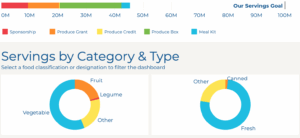In an outgrowth of the pandemic, food banks from New Hampshire to Texas to California are starting to permanently drop fees typically imposed on pantries.
When Covid first hit, food banks began temporarily lifting the shared maintenance fees pantries pay to food banks to help defray the costs of transporting, handling and storing donated food. This emergency measure helped to remove barriers to distributing food at a time when food access was paramount.
Now, aided by generous donations fueled by Covid, an increasing number of food banks — including some of the largest in the nation — believe they are well-positioned to drop the fees permanently. The savings for pantries are adding up to a few hundred dollars to $1,000 or so per month, depending on the size of the pantry.

“All food is free at Greater Boston Food Bank,” said Catherine D’Amato, President and CEO. “That’s a powerful statement if you want to offer consistent access to food.”
While shared maintenance fees are modest — amounting to 19 cents per pound or less, and applying only to a small portion of total food distributed — they can add up to a sizable income stream for a food bank, making the decision to eliminate them a weighty one.
Greater Boston Food Bank had started to think about waiving the fees as long as six or seven years ago, D’Amato said, but was deterred by the $1 million or so that they added annually to the bottom line. High levels of giving during the pandemic helped make the decision easier. “It was the right time to do it,” D’Amato said. “We have the resources.”
Eliminating shared maintenance fees had also been a long-term goal at Houston Food Bank, where the fees were covering only about 5% of operating costs, but still adding up to about $2 million in revenue annually, said Brian Greene, CEO.
The food bank had always suspended fees during and after disasters, such as Hurricane Ike in 2008 and Hurricane Harvey in 2017. In 2019, it started charging a flat rate per quarter based on what partners had been paying prior to Harvey. “This was done to at least remove the fee disincentive for partner agencies to do more,” Greene said in an email.

Now, Houston Food Bank has finally pulled the trigger on its goal. After initially treating Covid like a disaster scenario and temporarily suspending fees, it recently moved to drop them permanently.
At Second Harvest Food Bank of Orange County, getting rid of pantry fees had been a goal since the food bank’s founding. “It was a dream of our founder,” explained Claudia Keller, Chief Mission Officer. The food bank dropped the fees in the midst of the pandemic once it realized it could get by without the $500,000 or so they contributed annually to the bottom line, Keller said.
Getting rid of pantry fees was a stated goal at New Hampshire Food Bank five years ago when Eileen Liponis came on board as Executive Director. The food bank got halfway to its goal in 2017 when it used $800,000 of a $1 million anonymous donation to bring the shared maintenance fee down to about nine cents per pound. Generous Covid giving has now enabled it to fully eliminate the fee, Liponis said.
Disparity in the fundraising capabilities of food banks versus pantries helped Care and Share Food Bank of Colorado, make the decision to drop all fees to its 280 pantry partners. Lynne Telford, CEO, noted that the food bank has a robust fundraising operation, while most pantries do not. “It’s easier for us to raise money than for them, so we decided we will no longer charge,” she said.
The food banks now starting to eliminate fees join many of those outside the Feeding America network (also known as independent food banks) that have long abstained from fees. Food banks including Hunger Task Force of Wisconsin, Midwest Food Bank of Illinois, Farm Share of Florida and The Food Group of Minnesota, for example, have never charged fees to pantries.

To be sure, plenty of food banks continue to impose fees on pantries. These food banks note that most of the items they distribute have no fee at all. Many also operate in states that offer grants or other funding to pantries in need, they say.
Pantries, of course, welcome any movement toward fewer fees. “The pantries love it,” noted Keller of Second Harvest Food Bank of Orange County. “We want them to reinvest that money into their own infrastructure, which is important to us as we march toward more perishable food.”
“The pantries are thrilled,” agreed Liponis of New Hampshire. “It gives them freedom to purchase coolers and freezers so they can store fresh food,” she said, adding, “We’re trying to do as much as we can with capacity building.”
Fresh Start, a Colo.-based food partner of Care and Share, said the absence of fees made it easier to simply get food from the food bank, rather than spend time trying to find better deals from other sources. “We can really lean on the food bank,” noted Grant Winger, Executive Director.
In addition, Fresh Start has been able to use the $400 per month it was spending on food-bank food to make improvements, including installing sensors on all its refrigerated units to prevent any incidence of spoiled food.
Along with more home deliveries and mass distributions, the elimination of shared maintenance fees may emerge as a lasting legacy of the pandemic. “Sometimes,” noted D’Amato of Greater Boston Food Bank, “those really hard things become easier to do in hard times.” — Chris Costanzo
Like what you’re reading?
Support Food Bank News












